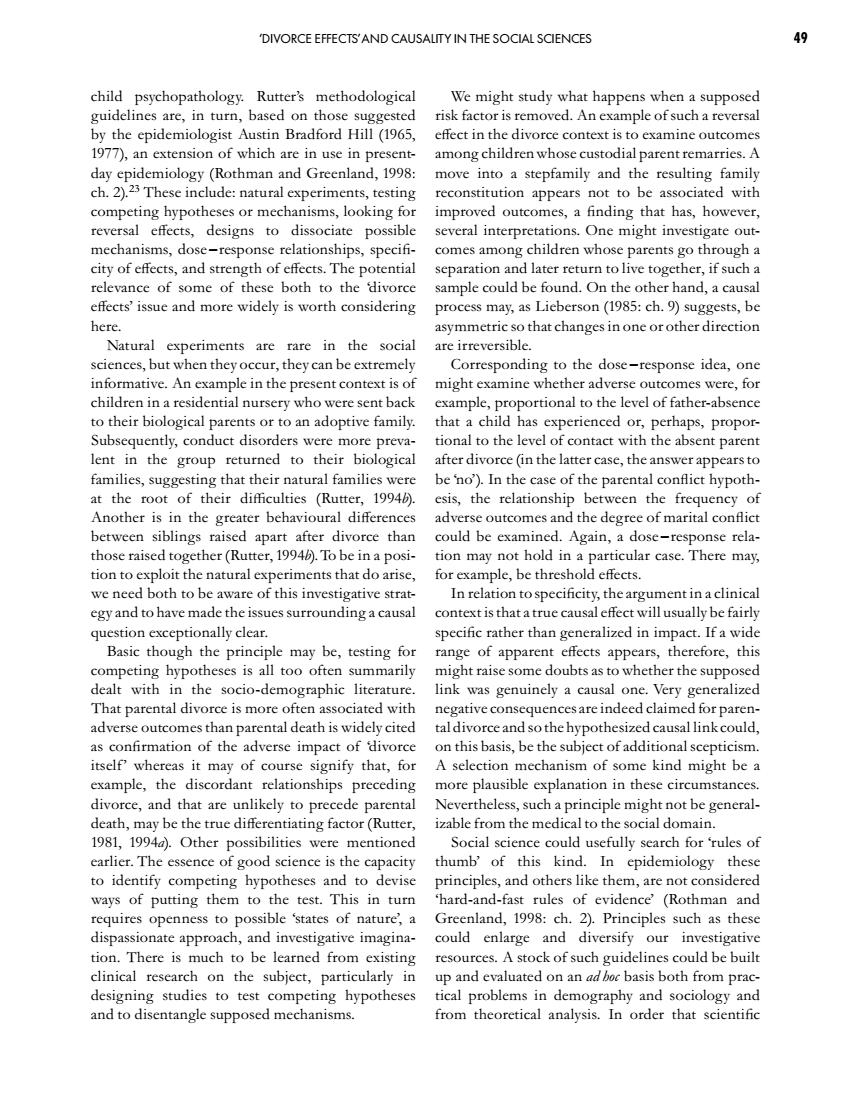正在加载图片...

DIVORCE EFFECTS'AND CAUSALITY IN THE SOCIAL SCIENCES 49 child psychopathology.Rutter's methodological We might study what happens when a supposed guidelines are,in turn,based on those suggested risk factor is removed.An example of such a reversal by the epidemiologist Austin Bradford Hill (1965, effect in the divorce context is to examine outcomes 1977),an extension of which are in use in present- among children whose custodial parent remarries.A day epidemiology (Rothman and Greenland,1998: move into a stepfamily and the resulting family ch.2).23 These include:natural experiments,testing reconstitution appears not to be associated with competing hypotheses or mechanisms,looking for improved outcomes,a finding that has,however, reversal effects,designs to dissociate possible several interpretations.One might investigate out- mechanisms,dose-response relationships,specifi- comes among children whose parents go through a city of effects,and strength of effects.The potential separation and later return to live together,if such a relevance of some of these both to the divorce sample could be found.On the other hand,a causal effects'issue and more widely is worth considering process may,as Lieberson(1985:ch.9)suggests,be here. asymmetric so that changes in one or other direction Natural experiments are rare in the social are irreversible. sciences,but when they occur,they can be extremely Corresponding to the dose-response idea,one informative.An example in the present context is of might examine whether adverse outcomes were,for children in a residential nursery who were sent back example,proportional to the level of father-absence to their biological parents or to an adoptive family. that a child has experienced or,perhaps,propor- Subsequently,conduct disorders were more preva- tional to the level of contact with the absent parent lent in the group returned to their biological after divorce (in the latter case,the answer appears to families,suggesting that their natural families were be no').In the case of the parental conflict hypoth- at the root of their difficulties (Rutter,19946). esis,the relationship between the frequency of Another is in the greater behavioural differences adverse outcomes and the degree of marital conflict between siblings raised apart after divorce than could be examined.Again,a dose-response rela- those raised together(Rutter,19946).To be in a posi-tion may not hold in a particular case.There may, tion to exploit the natural experiments that do arise, for example,be threshold effects. we need both to be aware of this investigative strat- In relation to specificity,the argument in a clinical egy and to have made the issues surrounding a causal context is that a true causal effect will usually be fairly question exceptionally clear. specific rather than generalized in impact.If a wide Basic though the principle may be,testing for range of apparent effects appears,therefore,this competing hypotheses is all too often summarily might raise some doubts as to whether the supposed dealt with in the socio-demographic literature. link was genuinely a causal one.Very generalized That parental divorce is more often associated with negative consequences are indeed claimed for paren- adverse outcomes than parental death is widely cited taldivorce and so the hypothesized causal link could, as confirmation of the adverse impact of divorce on this basis,be the subject of additional scepticism. itself'whereas it may of course signify that,for A selection mechanism of some kind might be a example,the discordant relationships preceding more plausible explanation in these circumstances. divorce,and that are unlikely to precede parental Nevertheless,such a principle might not be general- death,may be the true differentiating factor(Rutter,izable from the medical to the social domain. 1981,1994).Other possibilities were mentioned Social science could usefully search for 'rules of earlier.The essence of good science is the capacity thumb'of this kind.In epidemiology these to identify competing hypotheses and to devise principles,and others like them,are not considered ways of putting them to the test.This in turn 'hard-and-fast rules of evidence'(Rothman and requires openness to possible 'states of nature,a Greenland,1998:ch.2).Principles such as these dispassionate approach,and investigative imagina-could enlarge and diversify our investigative tion.There is much to be learned from existing resources.A stock of such guidelines could be built clinical research on the subject,particularly in up and evaluated on an adboc basis both from prac- designing studies to test competing hypotheses tical problems in demography and sociology and and to disentangle supposed mechanisms. from theoretical analysis.In order that scientific
I 4
+
7 $ #%&E- %&..*
#I
K %&&'A
9* 9= 5
A
"
3
>
3
3
5
2 3
4
<
+
"
G
#I %&&C
* +
3
#I %&&C
* 5
7
5
2
4
"
3 #I %&'% %&&C* 1
5
5
2
4
5
/
?
"
+
3
+
1
1
J
#%&'-A
&*
)
>
#
24* !
B
B +
>
5
3
!
3
0 ! 3
"
; 0
0
"
/
+
"
<
0
2
4
" !
"
2
4 #I
K %&&'A
9* 8
+
"
!
�������������������������������������������������������������������������������������������������������������������������������������������������������������������������������������������������������������������������������������������������������������������������������������������������������������������������������������������������������������